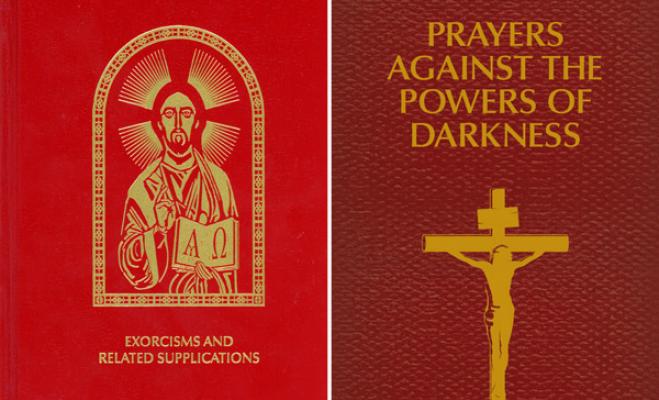
WASHINGTON — The first official English-language translation of the ritual book “Exorcisms and Related Supplications” is available from the U.S. Conference of Catholic Bishops.
Distribution of “Exorcisms and Related Supplications” is limited to bishops, though exorcists, other clergy, scholars and seminary professors also can obtain a copy with the permission of a bishop.
Having it available now in English “should make it easier for a bishop to find a priest who can help him with this ministry,” said Father Andrew Menke, executive director of the USCCB’s Secretariat of Divine Worship.
“Given that there’s less facility in Latin than there used to be, even among priests, it opens the door to more priests to do this. Until now, not only did the priest have to be wise and holy, but he also had to have strong facility in Latin,” Father Menke told Catholic News Service.
“It makes it easier for a priest who might otherwise be a good exorcist but who would be intimidated by a requirement to use a Latin text. Having it available in the vernacular means he can concentrate on prayer and on the ritual, without needing to worry about working in another language,” he explained.
The translation is from the rite that was revised following the Second Vatican Council. It was promulgated in Latin in 1999 and then slightly amended in 2004. The revised text draws from rituals used by the Catholic Church for centuries.
The USCCB approved the English translation at its 2014 fall general assembly. The Vatican gave its “recognitio,” or approval, of the translation earlier this year.
Hearing prayers offered in English also can benefit the person seeking an exorcism, said Father Menke, who noted he is not an exorcist.
"The first and foremost reason for an exorcism is to rid the person of the demon. And whether the person understands what's being said or not is irrelevant on one level. They just want to be free of this oppression," he said.
"But at the same time, exorcists have told me that for some people it can be a big help to hear words that they understand, words that are consoling, words that remind them of the power of Christ over the demons. There's a certain confidence that comes from hearing these words," he said.
For others, hearing the exorcism rite carried out in Latin can be consoling in its own way, Father Menke added, because the person "knows this is the prayer of the church."
Ultimately, it is the exorcist who chooses which language to use during the rite.
The main part of the book is the rite of major exorcism, and it also includes an introduction outlining criteria for its use. The text affirms the reality of evil in the world and more so affirms the sovereignty of Jesus to overcome any and all evil.
Under canon law — Canon 1172 specifically — only those priests who receive permission from their bishops can perform an exorcism after proper training. Bishops automatically have the right to perform an exorcism and can share that authority with other priests.
Please read our Comments Policy before posting.
Article comments powered by Disqus 'Cooking with Father Cooper' brings together food, faith
'Cooking with Father Cooper' brings together food, faith
 Supreme Court sets date for Kentucky's abortion case
Supreme Court sets date for Kentucky's abortion case
 Lifting dispensation did not bring Catholics back to Mass
Lifting dispensation did not bring Catholics back to Mass
 Quebec Cardinal Gérald Lacroix speaks of hope for healing
Quebec Cardinal Gérald Lacroix speaks of hope for healing
 Pope congratulates retired pontiff on ordination anniversary
Pope congratulates retired pontiff on ordination anniversary
 Winning directory photo honors Our Lady of Guadalupe
Winning directory photo honors Our Lady of Guadalupe
 St. Paul says: How does the Bible define love?
St. Paul says: How does the Bible define love?
 6 steps to getting married in Diocese of Little Rock
6 steps to getting married in Diocese of Little Rock
 Most frequently asked questions on Catholic marriage
Most frequently asked questions on Catholic marriage
 St. Joseph a model of solidarity with immigrants
St. Joseph a model of solidarity with immigrants
 Two gifts after Jesus’ death: Virgin Mary and Eucharist
Two gifts after Jesus’ death: Virgin Mary and Eucharist
 Why we have an altar, and not just a communion table
Why we have an altar, and not just a communion table
 Pope: Wars should be resolved through nonviolence
Pope: Wars should be resolved through nonviolence
 Living relationship with Jesus Christ in the Eucharist
Living relationship with Jesus Christ in the Eucharist